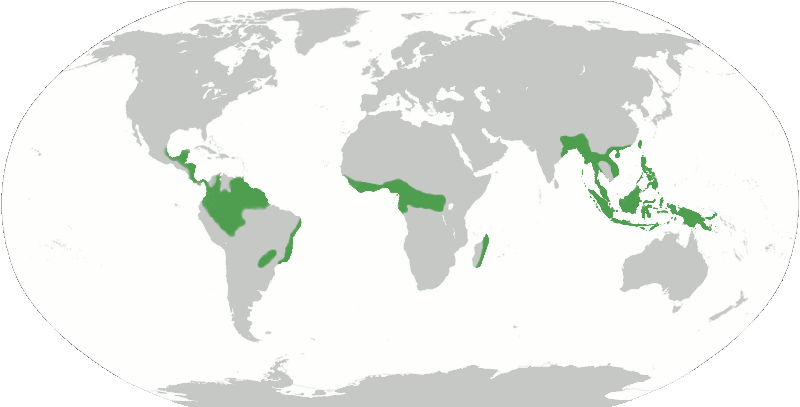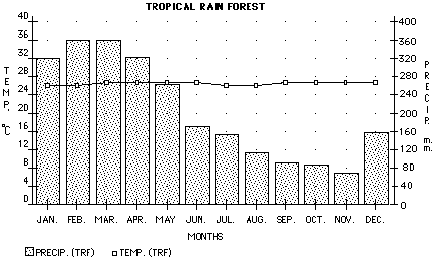Tropical Rain Forest Biome
 | IntroductionTheTropical Rainforest is a majestic place of beauty to tourists and photographers alike, but it is much more than that. As you will learn from this website, the Tropical Rainforest is a thriving community of life and energy. For a place to be called a tropical rainforest, it must fit certain criteria. For example, the place must fall between 23.5N and 23.5S on the latitude scale in order to be considered in "the tropics." Also, according to thefreedictionary.com, "Rainforests" are defined as "A dense evergreen forest with an annual rainfall of at least 406 centimeters (160 inches)." In review, "Tropical Rainforests" must be within a specific placement on the globe, and have to have lots of trees and lots of rain. Fun Fact: Temperatures in the Tropical Rainforest almost never go above 93°F and almost never fall below 68°F Simple enough! |
 | To the left, you'll find a climatogram about the Tropical Rain Forest. Climatograms record the average precipitations and temperatures (and sometimes other factors) to help predict weather and climate patterns in a certain kind of area. |
What Exactly Can Be Found Here? Why is it found here?
A giant variety of animals and plants are found in the Tropical Rainforest: in fact, the rainforests are the place in the world with the most diversity in plant life. Just some examples of animals would be toucans, macaws, cheetahs, and tigers. And though the names may not be among the things you were told in 6th grade, there are also many incredible plant species such as Saprophytes, Buttress Roots, and Venus Flytraps.
These wonderful plants have (obviously) adapted to their surroundings (as well as the animals). One mighty fine example of this would be the Buttress Root Trees. Besides having a name you want to laugh at, these trees are also great at changing according to their environment.
Buttress trees have roots that grow up along the sides of the trees up to 30 feet before blending in with the trunk of the tree. Why? Because the roots can't get as deep as they need to to provide all the stability needed, so like a true Macgyver, evolution allows this tree species to support itself unconventionally based on its surroundings and conditions.
National Parks
One example of a national park in the Tropical Rainforest would definitely be the Corvovado National Park of Costa Rica. The park keeps natural habitats of native animals and is 161 sq miles in area! Visitors are encouraged to spend a day there to observe the wonders of the area, and some even camp out in the park for multiple days.